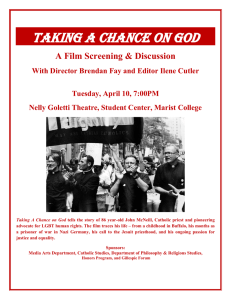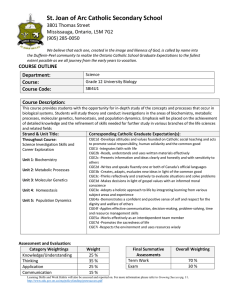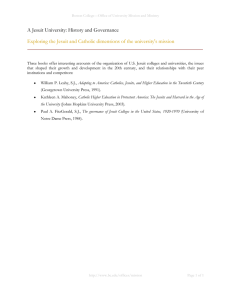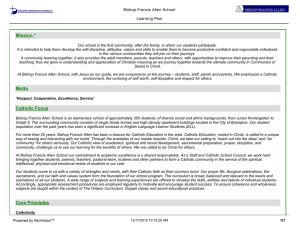33 Sunday (A) November 16, 2008. Joseph T. Nolan
advertisement
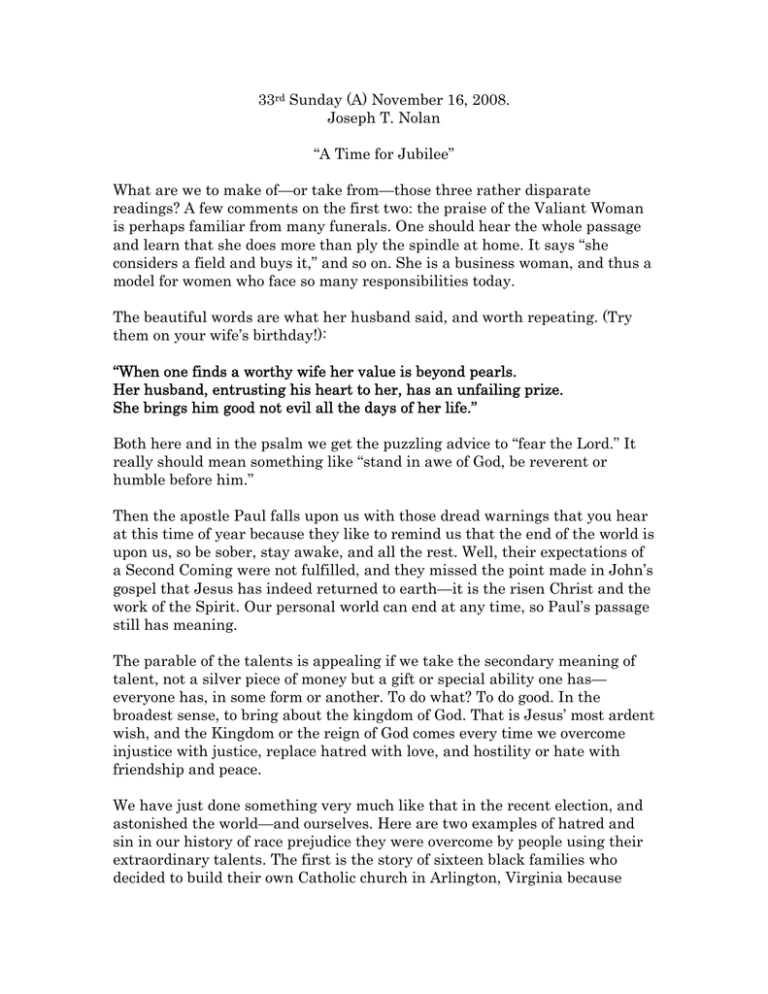
33rd Sunday (A) November 16, 2008. Joseph T. Nolan “A Time for Jubilee” What are we to make of—or take from—those three rather disparate readings? A few comments on the first two: the praise of the Valiant Woman is perhaps familiar from many funerals. One should hear the whole passage and learn that she does more than ply the spindle at home. It says “she considers a field and buys it,” and so on. She is a business woman, and thus a model for women who face so many responsibilities today. The beautiful words are what her husband said, and worth repeating. (Try them on your wife’s birthday!): “When one finds a worthy wife her value is beyond pearls. Her husband, entrusting his heart to her, has an unfailing prize. She brings him good not evil all the days of her life.” Both here and in the psalm we get the puzzling advice to “fear the Lord.” It really should mean something like “stand in awe of God, be reverent or humble before him.” Then the apostle Paul falls upon us with those dread warnings that you hear at this time of year because they like to remind us that the end of the world is upon us, so be sober, stay awake, and all the rest. Well, their expectations of a Second Coming were not fulfilled, and they missed the point made in John’s gospel that Jesus has indeed returned to earth—it is the risen Christ and the work of the Spirit. Our personal world can end at any time, so Paul’s passage still has meaning. The parable of the talents is appealing if we take the secondary meaning of talent, not a silver piece of money but a gift or special ability one has— everyone has, in some form or another. To do what? To do good. In the broadest sense, to bring about the kingdom of God. That is Jesus’ most ardent wish, and the Kingdom or the reign of God comes every time we overcome injustice with justice, replace hatred with love, and hostility or hate with friendship and peace. We have just done something very much like that in the recent election, and astonished the world—and ourselves. Here are two examples of hatred and sin in our history of race prejudice they were overcome by people using their extraordinary talents. The first is the story of sixteen black families who decided to build their own Catholic church in Arlington, Virginia because they were not welcome in the white Catholic parish. The time? As recent as 1947. How unwelcome were they? They had to sit in a few pews in the rear, and—listen to this—these pews were roped off after they were seated to keep them from going to Communion until the white Catholics had gone up and received this sacrament of unity. The woman who tells the story says, “It was difficult if not impossible to be a community of faith in such a setting!” Listen to her further comments: “There was a parish in Alexandria that welcomed us and treated us with dignity.” And that’s where her three children were baptized.” But she adds, “The trouble was it took three buses and much standing and rain or snow or cold or blistering heat to get them from Arlington’s black section. We should pause there, and blush. What kind of inconvenience do we accept to go and worship the living God? The solution? “Build our own church.” The bishop approved, and the Holy Ghost fathers agreed to staff it. And so, “We had lawn parties. We had everything you could think of to raise money. A big collection those days was 40 dollars a week. Those who could afford it put in a dollar, which was big money.” They would also take the bus into Washington’s poorer sections to sell bundles of used clothing they had collected. The church was completed and blessed on Pentecost, 1947. No stained glass windows, frosted glass had to suffice. But no matter, it was their church. Her son became the first altar server. Her two daughters had the first weddings there. It is difficult to realize all this was the ugly status quo. But not long ago I read of another example so ugly it blows the mind. It comes from an impeccable source—a bishop, one of our own in Brooklyn, who grew up in Mississippi seventy or eighty years ago. His Catholic church was, of course, segregated and the black Catholics had also built their own. But when one of their most beloved people, a leader in the community, died and the funeral would certainly overflow their small space, the white pastor agreed to let them use the bigger Catholic church for the funeral. He disliked the segregation, and figured on this occasion it would be for blacks only. Did this happen? Yes—and what followed is hard to believe: some of the white parishioners gathered outside the church and stoned the casket as it was carried out. The boy, now the bishop, said he wanted to become a priest like that pastor who dared to break the barrier and who suffered from it. Perhaps you have never lived or worked in the south in the days of segregation. I did. In southern Maryland one summer I was one of four students working on a farm. We were briefed when we arrived that there were two Catholic churches, and in one the blacks were put in the balcony; and the other, they sat on the right side of the church, the whites on the left. That amused me because the gospel gives the place of honor to those on the right; Jesus calls them the sheep and those on the left the goats! But listen: we almost got in big trouble when one of us wanted to give a coke to a little six-year-old black girl. Six years old! When I went to Arkansas as a law enforcement officer, I took the train from Little Rock to Fort Smith and sat beside a priest. He told me the city had three Catholic churches: one for the Irish, one for the Germans, and one for the blacks on the outskirts of town. Then he remembered another: Christ the King, and I said, “I suppose that’s for everyone!” He also added that “we have no trouble with the blacks as long as they keep their place.” I wonder what he would think now, when the country has decided that the place for one of them is the White House. The Catholic church with some exceptions had a tardy and even shameful history of racism. The move to end the slave trade came from England in the early 1800’s, and the United States actually had to evade British warships to get slave cargo to our shores. The move to end slavery itself came from the conscience of an Anglican layman and the Quaker community. In this country by mid-century the Quakers agreed to stop owning slaves. And so, finally, did the Jesuit province of Maryland. But the Quakers stopped, and set their slaves free. The Jesuits stopped, and sold them off. They sold them down south, presumably to good-hearted owners who would keep the families together—which didn’t happen. This is still a cause of pain and reparation at Georgetown University, because part of the proceeds from the sale helped to support the university. What about other Jesuit universities? A Jesuit who fought mightily to integrate St. Louis University right after the war was hugely criticized. At Boston College we had a black player on the football team in 1942, the year we went to the Sugar Bowl in New Orleans. His name was Will Montgomery. He went with the team but of course he couldn’t play, and couldn’t even stay with them in the same lodging. Never mind history—rejoice in the present. All that or so much of it, is behind us now. A time for jubilee.
